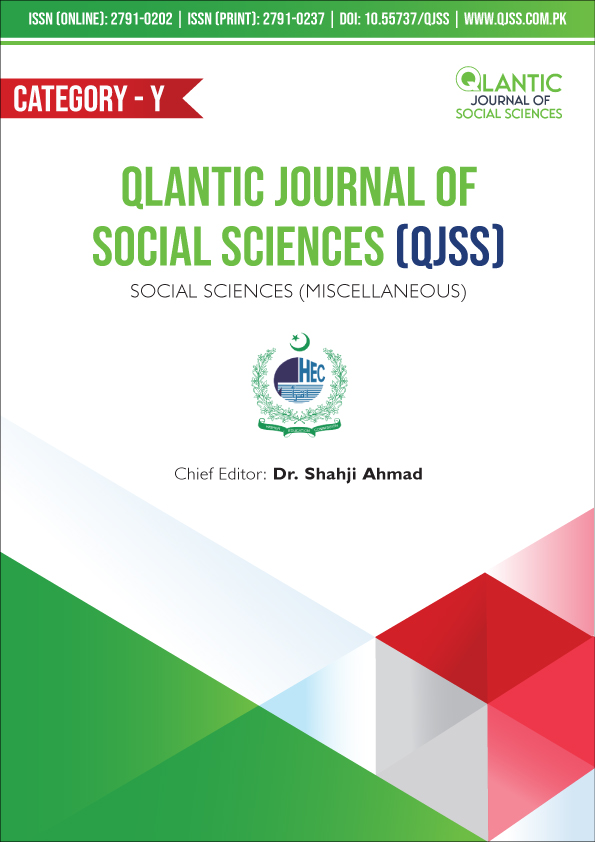Grid Resilience and Green Transformation: Investigating the Synergy of Economic, Technical, and Policy Factors in Renewable Integration in South Asia
DOI:
https://doi.org/10.55737/qjss.vi-i.25328Keywords:
Renewable Energy (RE), Renewable Energy Capacity (REC), Non-Renewable Energy (NRE), Fully-Modified Ordinary Least Square (FMOLS), Dynamic Ordinary Least Square (DOLS)Abstract
Electricity is known as the engine of economic progress and development, but the source of energy use has a profound impact on environmental degradation. Indeed, clean energy significantly reduces greenhouse gas emissions and pollution, whereas traditional energy has numerous costs, such as environmental degradation, health issues, and depletion of energy sources. The study examines the impact of technical, economic, and policy factors on grid resilience in South Asian economies from 2000-2023, revealing a significant correlation between these factors. The Kao cointegration test verifies a long-run association among variables and underscores the interdependence of technical, economic, and policy magnitude. In fact, the outcomes of FMOLS and DOLS reveal that increased investment in renewable energy and improved renewable energy capacity considerably decrease electricity distribution losses and strengthen grid resilience. Conversely, higher CO2 emissions negatively influence grid efficiency and sustainability. Policy factors, deliberate through the Country Policy and Institutional Assessment (CPIA), reveal the vital role of robust environmental policies and institutional frameworks in falling vulnerabilities and improving grid consistency. The study suggests targeted interventions, including planned investments in renewable energy infrastructure, embracing advanced technical solutions, and policy and institutional restructuring, to strengthen grid resilience and ensure sustainable electricity distribution in the region. These are essential for authorities, stakeholders, policymakers, and stakeholders determined for long-term energy reliability and sustainability.
References
Al-mulali, U., Fereidouni, H. G., & Lee, J. Y. M. (2014). Electricity consumption from renewable and non-renewable sources and economic growth: Evidence from Latin American countries. Renewable and Sustainable Energy Reviews, 30, 290–298. https://doi.org/10.1016/j.rser.2013.10.006
Apergis, N., & Payne, J. E. (2011). The renewable energy consumption–growth nexus in Central America. Applied Energy, 88(1), 343–347. https://doi.org/10.1016/j.apenergy.2010.07.013
Apergis, N., & Payne, J. E. (2012). The electricity consumption-growth nexus: Renewable versus non-renewable electricity in central America. Energy Sources Part B: Economics, Planning and Policy, 7(4), 423–431. https://doi.org/10.1080/15567249.2011.639336
Asian Development Bank (ADB). (2023). Energy Integration in Asia: Meeting Demand and Climate Goals. ADB Publications.
Aziz, S., Ahmed, I., Khan, K., & Khalid, M. (2024). Emerging trends and approaches for designing net-zero low-carbon integrated energy networks: A review of current practices. Arabian Journal for Science and Engineering, 49(5), 6163-6185. https://doi.org/10.1007/s13369-023-08336-0
Bagherian, M. A., & Mehranzamir, K. (2020). A comprehensive review on renewable energy integration for combined heat and power production. Energy Conversion and Management, 224(113454), 113454. https://doi.org/10.1016/j.enconman.2020.113454
Bhattacharya, M., Paramati, S. R., Ozturk, I., & Bhattacharya, S. (2016). The effect of renewable energy consumption on economic growth: Evidence from top 38 countries. Applied Energy, 162, 733–741. https://doi.org/10.1016/j.apenergy.2015.10.104
Government of India, Ministry of New and Renewable Energy. (2023). National Solar Mission and Wind Energy Programs.
International Energy Agency (IEA). (2022). ^ßIEA.
International Renewable Energy Agency (IRENA). (2021). Renewable Power Generation Costs in 2020. IRENA.
IRENA (2022). Renewable energy and socio-economic benefits in Asia. International Renewable Energy Agency.
Kahia, M., Aïssa, M. S. B., & Lanouar, C. (2017). Renewable and non-renewable energy use-economic growth nexus: The case of MENA Net Oil Importing Countries. Renewable and Sustainable Energy Reviews, 71, 127–140. https://doi.org/10.1016/j.rser.2017.01.010
Kumar, G. M. S., & Cao, S. (2021). State-of-the-art review of positive energy building and community systems. Energies, 14(16), 5046. https://doi.org/10.3390/en14165046
Li, B., Rahman, M. M., & Haneklaus, N. (2024). Assessing China's energy transition pathway: Insights from the synergistic effects of key drivers. Energy Strategy Reviews, 55, 101528. https://doi.org/10.1016/j.esr.2024.101528
Li, L., & Li, Y. (2022). The spatial relationship between CO2 emissions and economic growth in the construction industry: Based on the Tapio decoupling model and STIRPAT model. Sustainability, 15(1), 528. https://doi.org/10.3390/su15010528
Lotze, J., Moser, M., Savvidis, G., Keles, D., & Hagenmeyer, V. (2024). The complementary role of energy system and power grid models: An analysis of the European energy transformation from a holistic perspective. Energy Conversion and Management, 315(118761), 118761. https://doi.org/10.1016/j.enconman.2024.118761
Lund, H., Østergaard, P. A., Connolly, D., & Mathiesen, B. V. (2017). Smart energy and smart energy systems. Energy, 137, 556-565. https://doi.org/10.1016/j.energy.2017.05.123
Lund, H., Østergaard, P. A., Connolly, D., & Mathiesen, B. V. (2015). Smart energy and smart grids: The role of grid resilience in renewable energy integration. Energy, 92, 866–872.
Martinot, E. (2016). Grid integration of renewable energy: flexibility, innovation, and experience. Annual Review of Environment and Resources, 41(1), 223-251. https://doi.org/10.1146/annurev-environ-110615-085725
Ministry of Power, India (2022). National Electricity Plan: Renewable Energy Targets.
Ministry of Power, India (2022). National Smart Grid Mission: A roadmap for grid modernization in India.
Pakistan Ministry of Climate Change. (2022). Pakistan's National Renewable Energy Policy 2030.
SAARC Secretariat (2017). SAARC Framework Agreement for Energy Cooperation.
Shukla, A. K., Sudhakar, K., & Baredar, P. (2017). Renewable energy resources in South Asian countries: Challenges, policy and recommendations. Resource-Efficient Technologies, 3(3), 342-346. https://doi.org/10.1016/j.reffit.2016.12.003
Usman, F. O., Ani, E. C., Ebirim, W., Montero, D. J. P., Olu-lawal, K. A., & Ninduwezuor-Ehiobu, N. (2024). Integrating renewable energy solutions in the manufacturing industry: Challenges and opportunities: A review. Engineering Science & Technology Journal, 5(3), 674–703. https://doi.org/10.51594/estj.v5i3.865
World Bank. (2022). Investing in Renewable Energy in South Asia: Challenges and Opportunities.
World Bank. (2023). South Asia Economic Focus: Regional Energy Consumption Trends. World Bank Group.
Zhong, S., & Lan, L. (2024). Innovative city construction and urban green total factor productivity. Environment, Development and Sustainability, 1-45. https://doi.org/10.1007/s10668-024-05721-z




